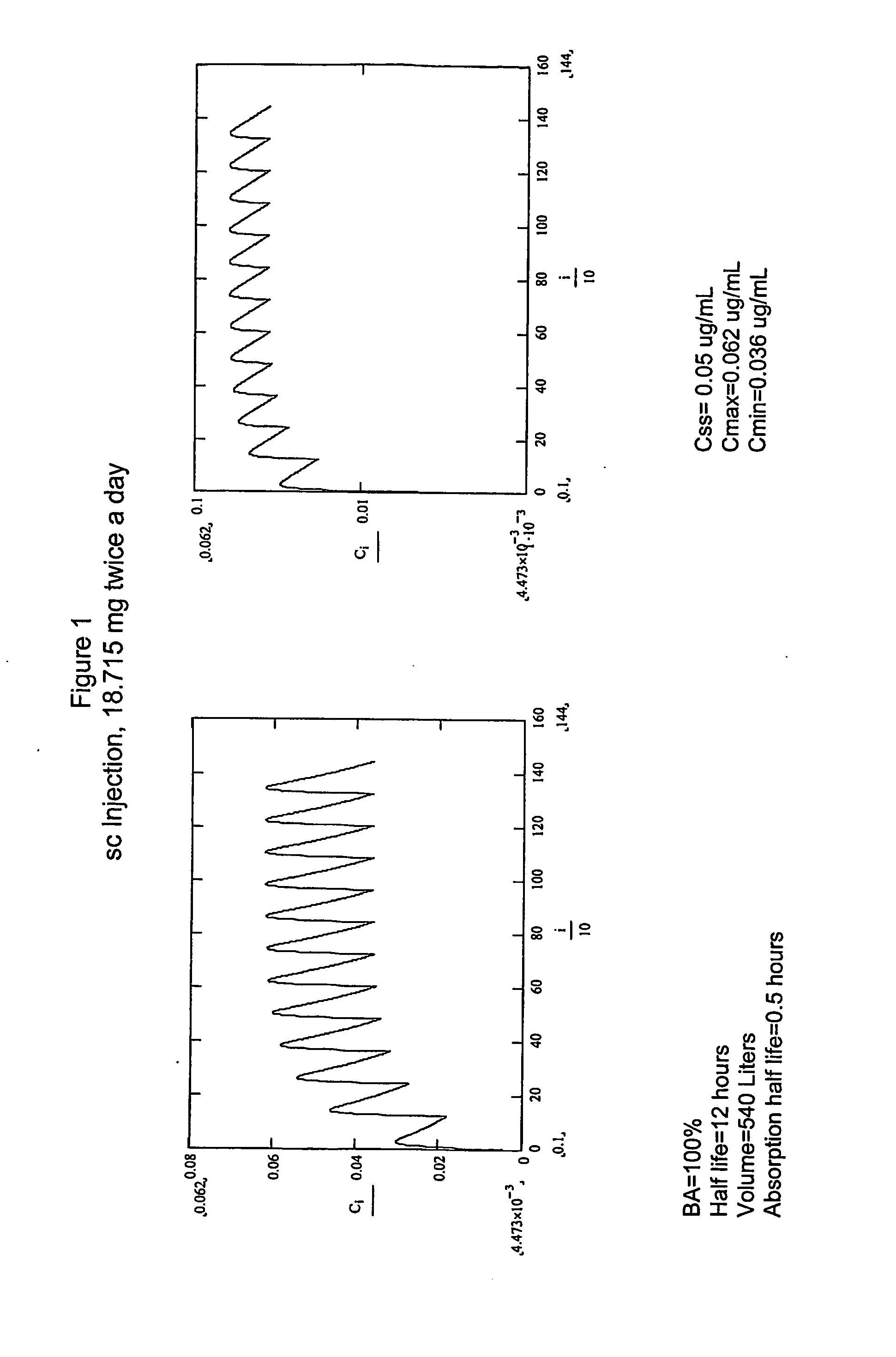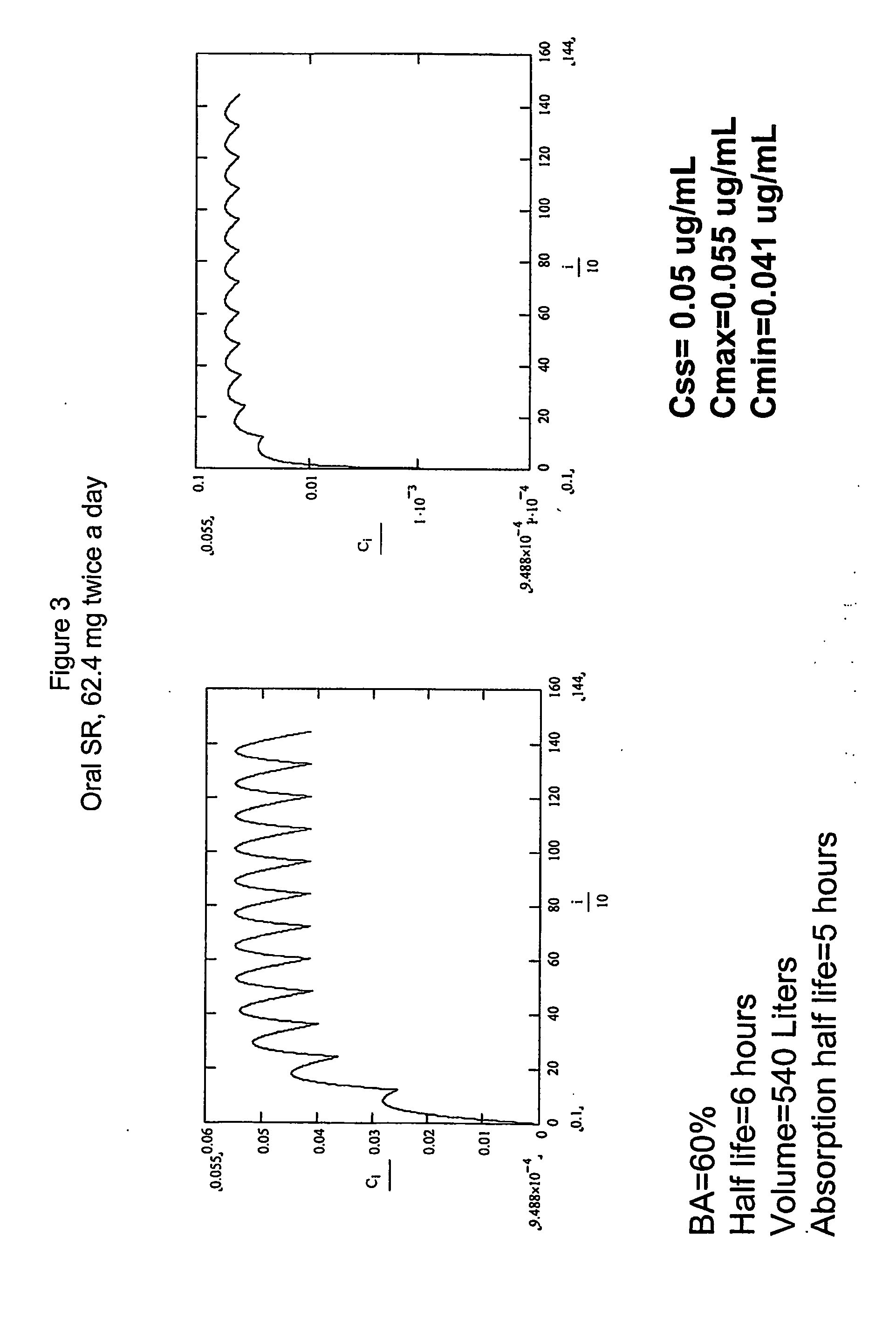Dosing regimens for the treatment of cancer
a cancer and dosing regimen technology, applied in the field of dosing regimens for the treatment of cancer, can solve the problems of hampered progress toward clinical candidate development and cell death in a number of cancer types
- Summary
- Abstract
- Description
- Claims
- Application Information
AI Technical Summary
Benefits of technology
Problems solved by technology
Method used
Image
Examples
example 1
Synthesis of an Analog of Cyclopamine
[0061]
Part A
[0062]
[0063]Cyclopamine 2 (20 mg, 0.049 mmol) was suspended in dry toluene (0.6 mL) and cyclohexanone (150 μL, 1.47 mmol, 30 eq), followed by aluminum isopropoxide (79 mg, 0.392 mmol, 8 eq). The resulting mixture was heated to reflux for 2 hours, cooled to room temperature, diluted with ethyl acetate and quenched with Rochelle's salt solution. The biphasic mixture was stirred overnight, the layers were separated, the aqueous layer was extracted with ethyl acetate, and the combined organic extracts were dried (over mgSO4), filtered and concentrated in vacuo. The residue was purified by flash chromatography (DCM, DCM / methanol 98:2 and 95:5). Compound 3 was obtained as a white crystalline solid (70% yield).
Part B
[0064]
[0065]Diiodomethane (40 μl, 0.5 mmol, 2.5 eq) in DCM (0.52 mL) at 0° C. was treated with 15% diethylzinc in toluene (0.2 mL, 0.2 mmol 1 eq), and the resulting solution was stirred for 5 minutes, at which point a white preci...
example 2
[0068]A study was performed in mouse PC-3 prostate xenograft models to assess the ability of the methods of the present invention to reduce subcutaneous tumor burden. In the study male athymic nude (Nu / Nu) mice were implanted with PC-3 cells (1×107 cells) into the flank of the left leg. When the average tumor size reached 200 mm3 animals were randomly assigned to treatment groups (N=12 / group). Mice were implanted with Alzet mini pumps containing either the HCl salt of compound 1 or vehicle (30% HPBCD in WFI). The mini pumps were surgically implanted subcutaneously on the flank of the right leg, contralateral to the site of the tumor implant. The pumps were replaced with new pumps every 6th day of the study. In the study, mice received either vehicle or the test compound at 10.6 mg / kg / day. Tumor volumes for each group were measured at regular intervals during treatment. The animals were sacrificed after 25 days of treatment and tumor volumes were compared. The results of this experim...
example 3
[0070]A study was performed in mouse SKOV-3 xenograft models to assess the ability of the methods of the present invention to reduce subcutaneous tumor burden. Male athymic nude (Nu / Nu) mice were implanted with SKOV-3 cells (1×107 cells) into the flank of the left leg. When the average tumor size reached 50 mm3, animals were randomly assigned to treatment groups. Mice were implanted with Alzet mini pump containing the HCl salt of compound 1 or vehicle (30% HPBCD in WFI). The mini pumps were surgically implanted subcutaneously on the flank of the right leg, contralateral to the site of the tumor implant. The pumps were replaced with new pumps every 6th day of the study. Mice received either vehicle (N=13 / group), or the test compound at 10.6 mg / kg / day (N=13 / group) or 20 mg / kg / day (N=5 / group). Tumor volumes of the two groups were measured at regular intervals during treatment, which lasted 74 days. The results of this experiment are summarized below. As shown, when mice were treated wi...
PUM
| Property | Measurement | Unit |
|---|---|---|
| Fraction | aaaaa | aaaaa |
| Fraction | aaaaa | aaaaa |
| Fraction | aaaaa | aaaaa |
Abstract
Description
Claims
Application Information
 Login to View More
Login to View More - R&D
- Intellectual Property
- Life Sciences
- Materials
- Tech Scout
- Unparalleled Data Quality
- Higher Quality Content
- 60% Fewer Hallucinations
Browse by: Latest US Patents, China's latest patents, Technical Efficacy Thesaurus, Application Domain, Technology Topic, Popular Technical Reports.
© 2025 PatSnap. All rights reserved.Legal|Privacy policy|Modern Slavery Act Transparency Statement|Sitemap|About US| Contact US: help@patsnap.com



